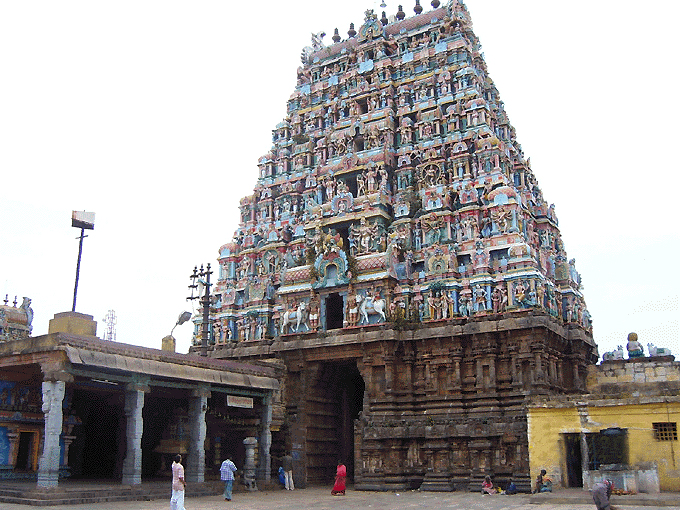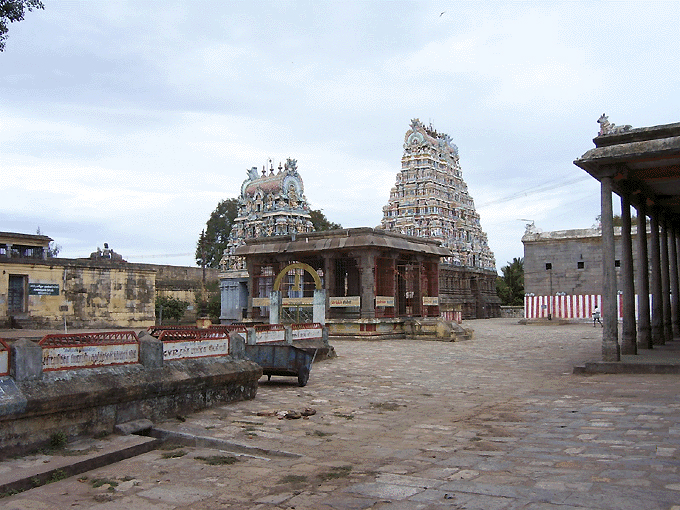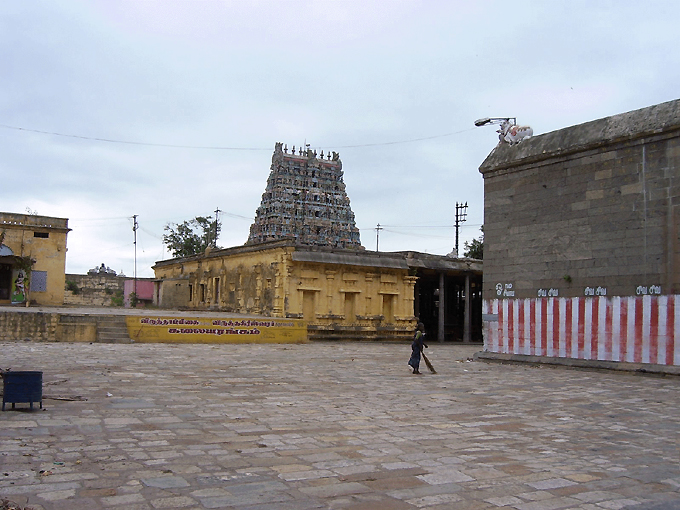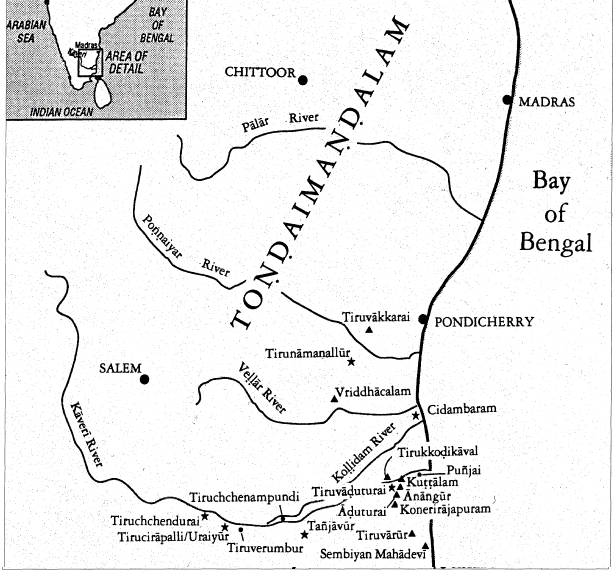
|
|
|
|
BY: SUN STAFF

Tirumudukundram Temple at Vrddhakasi Mar 07, CANADA (SUN) — A serial exploration of the holy sites visited by Lord Caitanya. Vrddhakasi
In yesterday's segment on Siddhavata tirtha, the closing sloka, Sri Caitanya-caritamrta Madhya Lila 9.38, stated that after showing His mercy to the brahmana who converted from chanting 'Rama' to chanting Krsna's Name, the Lord traveled on to Vrddhakasi and the temple of Lord Shiva.
Madhya lila 9 "A summary of the Ninth Chapter is given by Srila Bhaktivinoda Thakura. After leaving Vidyanagara, Sri Caitanya Mahaprabhu visited such places of pilgrimage as Gautami-ganga, Mallikarjuna, Ahovala-nrsimha, Siddhavata, Skanda-ksetra, Trimatha, Vrddhakasi, Bauddha-sthana, Tirupati, Tirumala, Pana-nrsimha, Siva-kanci, Visnu-kanci, Trikala-hasti, Vrddhakola, Siyali-bhairavi, Kaveri-tira and Kumbhakarna-kapala." The verses from Madhya Lila 9.35-37 describe the very process by which Sri Caitanya opened the floodgates of love of God, distributing the Holy Name to the brahmana and so many other residents of South India: "My worshipable Lord has been Lord Ramacandra, and by chanting His holy name I received happiness. Because I received such happiness, I chanted the holy name of Lord Rama day and night. By Your appearance, Lord Krsna's holy name also appeared, and at that time the glories of Krsna's name awoke in my heart. Sir, You are that Lord Krsna Himself. This is my conclusion." Saying this, the brahmana fell down at the lotus feet of Sri Caitanya Mahaprabhu."

Tirumudukundram Temple at Vrddhakasi In his purport to Madhya Lila 9.38-39, we get some interesting details on Vrddhacalam tirtha: Madhya 9.38
"After showing mercy to the brahmana, Lord Sri Caitanya Mahaprabhu left the next day and arrived at Vrddhakasi, where He visited the temple of Lord Siva. PURPORT Madhya 9.39
Sri Caitanya Mahaprabhu then left Vrddhakasi and proceeded further. In one village He saw that most of the residents were brahmanas, and He took His rest there."

Tirumudukundram Temple Complex In the case of Vrddhakasi, we have ample evidence in sastra for the location of the tirtha, and the place is easily found on modern maps. There are a number of variations in spelling for this tirtha: Vrddhakasi (Vrddha-kasi), Vriddhakasi (Vriddha-kasi), Vrddhacalam (Vrdha-calam), and Vriddhacalam (Vriddha-calam). As Srila Prabhupada notes in his purport above, Vrddhakasi is also known by the more ancient place name of Kalahastipura. Being located in Tamil Nadu, it is known locally by the Tamil name, Thirumudukundram. We should note that there is also an ancient village of Kalahastipura in Karnataka, which is today known as Kolar. Virudhachalam is a municipality and taluk headquartered in Cuddalore district of Tamil Nadu. The name 'Vriddhachalam' is derived from the Sanskrit vriddham, which means 'ancient', and achalam, or 'mountain'. Likewise, the Tamil name 'Thirumudhukundram' means 'old mountain'. The Manimukha River (also known as the Manimuthar) that flows through Vrddhakasi in the Southern Arcot district is now commonly known as the Vellar River. The Vellar originates in the Shevaroy Hills and runs through the districts of Salem, Perambalur and Cuddalore in the northern part of Tamil Nadu, then flows into the Bay of Bengal near Parangipettai. The Shiva Temple at Viddhakasi Today there are a few Shiva temples in the area of Viddhakasi. In fact, the village is surrounded on all four sides by temples. One of the Shiva temples, the Kolanjiapper Temple, is only about 200 years old. It is well known today for its Murugan worship. The very ancient temple that Lord Caitanya visited is the Thirumudukundram Temple, also known as the Sri Vridhagiriswarar Temple after its presiding Deity, Vridhagiriswar Shiva. It is also called the Palamalai Nadhar Temple, and it is one of the oldest in Tamil Nadu. Palamalai Nadhar, another name for Lord Shiva, is associated with the story of the devotee Sundarar, who received 12,000 gold coins from Lord Palamalainathar. The quality of the gold was checked by Matru Uraitha Vinayakar (Ganesh), then the coins were thrown into the river. They were collected again from the water at Kamalalayam, Tiruvarur. Sri Vinayakar again checked the quality of the gold coins at Tiruvarur. This pastime is sung by Dikshitar, Sri Mahaganapatiravathumam in Gowlai.

The location of Vriddhagirisvara Temple, shown on the map above, has Vriddhacalam marked by a triangle. The triangles designate villages in which Sembiyan Mahadevi, a well known patron, had various temples built. Numerous other temple constructions including towers, mandapas (pavilions) and prakaras (compounds), were raised in Vriddhacalam by the Vijayanagar Viceroy, Chevvappa Nayaka. The Vriddhagirisvara Temple has five praharams (interior walkways), five dwajasthambams (poles), Azhathu Pillayar (Ganesh murtis), 2 Ambals (Devi deities), and 2 Utavars (processional deities). Today, devotees still throng to Vriddhagirisvara Temple to take bath in the sacred Manimukha (Manimukthar) River. They also come here on the occasion of the Masi Magam festival. Ramanujacarya's Cousin, Govinda As Srila Prabhupada mentioned in his purport to Madhya 9.38, Govinda, the cousin of Ramanujacarya, worshipped Lord Shiva Vriddhagirisvara for many years at his Viddhakasi abode. Govinda is known as Sri Govinda Bhatta, and as Sri Embaar. Sri Govinda Bhatta was the maternal cousin of Sri Ramanuja. He was born in 1021 A.D., four years after Ramanuja, at a village called Madura Mangalam. His parents were Sridevi and Kamalanayana Bhatta. Sridevi, also known as Dyutimati, was the sister of Ramanuja's mother. Govinda and Ramanuja were disciples of Yadava Prakasha. During the course of their education, Ramanuja and Yadava Prakasha had many differences of opinion on philosophy. Due to these differences, Yadava and some his other students conspired to kill Ramanuja. On the pretext of arranging a pilgrimage to Kaasi for his students, Yadava invited both Ramanuja and Govinda, along with other students. Govinda came to known of the plot and warned Ramanuja, who in turn disappeared from the rest of the group. Ramanuja wandered around the forests, finally reaching the Deva Perumal temple at Kanchi. Further details of Govinda's life are given on many Srivaisnava sites. 'Govinda continued his journey to the Ganges with Yadava and the rest of the students. While bathing at the river, a Lingam floated into the hands of Govinda. When he pointed this out to Yadava, the teacher praised Govinda and gave him the title, Ullangkai Konarntha Nayanaar. After returning from the Ganges trip, Govinda proceeded to the Kalahasti Shiva temple (Vriddhagirisvara Temple at Viddhakasi), on the way from Madras to Tirupati, and there he began performing the duties of daily worship. For his role in saving the life of Ramanuja, thereby saving the whole Srivaisnava Sampradaya, Govinda is worshipped by Srivaisnavites today as Sri Embaar.

Tirumudukundram Temple Complex
| |